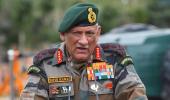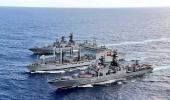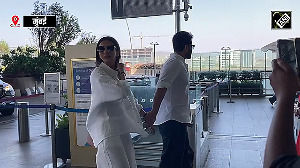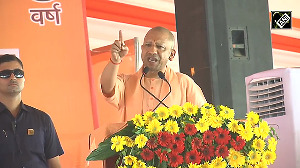Mere shuffling of resources or cosmetic changes to prove a point would be counterproductive in the long run, observes Commodore Venugoptal Menon (retd).

Background:
It may be recalled that the first Chief of Defense Staff assumed office on January 1, 2020 with a mandate which was centered on increasing coordination, tri service effectiveness and integration of overall combat capabilities of Indian Armed forces.
The mandate also included facilitating restructuring of military commands for optimal utilisation of resources by bringing about jointness in operations, including through establishment of joint/theatre commands.
In addition, the mandate aimed to optimise logistics, transport, training, support services, communications, repairs, and maintenance etc of the three services within three years of the first CDS assuming office.
The mandate by the government itself stands to scrutiny for dictating a time line to complete the process of integration of the armed forces which is directly linked to national security.
On a parallel, the United States's Goldwater Nichols act of 1986 was formulated based on extensive studies of the lessons learnt from the Vietnam War, failure of the Iranian hostage rescue mission in 1980 and the invasion of Grenada in 1983 in which joint operations held the key.
Whereas we have concluded on the necessity of major organisational restructuring of the Indian armed forces based on lessons learnt from a LICO in which the Navy had negligible role to play.
An important point relevant to the Kargil operations was that there was no declaration of war which would have otherwise resolved most of the observations of the committee.
Therefore, the premise for attributing the failures to lack of jointness itself is questionable.
Hence, the foundation of this major reform appears shaky from the start and the tearing hurry of the CDS to implement organisational restructuring adds to the complexity of the issue.
Notwithstanding this note of caution, I would like to examine the concept of envisaged maritime theatre command based on available open source information, identify its flaws and suggest an alternate model which could be deliberated.
Concept of Maritime Theatre Command, as published in the media
The envisaged Maritime Theatre Command would include the command and control of the entire Indian naval fleet and coastal defence operations.
The Maritime Theatre Command will incorporate the Western Naval Command, Eastern Naval Command, the Andaman Nicobar Command and the Indian Coast Guard.
The army element would consist of two amphibious brigades. The air element would include the maritime strike squadrons of the Indian Air Force.
The Maritime Theatre Command will be the first geographical theatr ecommand to be created as part of the biggest-ever military restructuring plan to build an integrated land, air, sea war fighting machinery for greater combat punch in a more cost effective manner.
The Maritime Theatre Command would be headed by a Vice Admiral and headquartered at Karwar.

The Structure of a Theatre Command
It is evident that the thought process of the establishment of the Maritime Theatre Command is more or less on the lines of the US military.
However, the most important point that the committee headed by the NSA missed out is the building of a strong foundation before the roof is built.
The Goldwater Nichols Act had emphasiSed on specific Joint Professional Military Education requirements for officers before they could attain flag rank, thereby preparing them for duty in joint assignments -- a mandatory requirement in planning and conduct of joint operations.
In this context, it is pertinent to mention that officers of the Indian armed forces get a very limited exposure to joint operations during the Staff course and the War course.
Hence, the big question is whether the senior staff appointed to the CDS organisation have the required expertise to carry out their role to plan and coordinate joint operations effectively.
Existing Command and Control organisation in the Indian Navy
The Indian Navy operates three commands -- the Western Naval Command headquartered at Mumbai, the Eastern Naval Command headquartered at Vishakhapatnam and the Southern Naval Command at Kochi (also known as the Training Command).
The Indian Navy operates two fleets: The Western Fleet and the Eastern Fleet.
The fleet commanders report to their respective Commanders in Chief.
Similarly, there are two Submarine bases, one each under the Western Naval Command and the Eastern Naval Command which controls the submarine operations in respective seaboards.
The fleet commanders and the Commodore Submarines report to the respective Commander in Chief.
The air arm of the Navy is headed by a Flag Officer Naval Aviation under the operational control of the Commander in Chief of the Western Command.
The air bases at Goa, Kochi and Vizag are under dual control of the Flag Officer Naval Aviation and the respective Commander in Chief.
Operational training is another important facet to ensure combat readiness of ships before they join their respective fleets.
This job is accomplished by the Flag Officer Sea Training who reports to the Commander in Chief of Southern Naval command.
There are two naval dockyards, one each at Mumbai and Vizag and a Naval Ship Repair Yard at Kochi.
Heads of these organisations report to their respective Commanders in Chief.
Each Command has a Material Organisation which is the logistics provider, a Naval Armament Depot, Missile bases etc, which are under the direct control of the respective Commanders in Chief.
In brief, the Commanders in Chief of the respective commands have direct control over all the facets under them to ensure optimum operational availability of ships and submarines under their command.
Area Of Jurisdiction
The primary mandate of the Indian Navy is to facilitate maritime security in our area of interest -- from the Strait of Hormuz in the west to the Malacca Straits in the east besides supporting the Coast Guard in its role of coastal security.
Geographic jurisdiction of these waters is equally shared by the Western Naval command and the Eastern Naval Command.

Operational Control at Naval Headquarters
The Deputy Chief of Naval Staff heads the operations branch (Staff Branch-II<) of the Indian Navy.
The DCNS oversees overall naval operations, however the operational control at the command level is decentralised to the respective Commanders in Chief.
The DCNS is one amongst the Principal Staff officers at Naval Headquarters and is part of the highest echelon of the Indian Navy organisation.
The others being the Vice Chief of Naval Staff, Chief of Personnel and the Chief of Material.
All four Principal Staff officers work in unison at the highest decision making level to ensure optimum availability of ships, submarines, and aircraft to fulfill the operational commitments of the Indian Navy.
In brief, the time tested existing command and control structure is a well-oiled machine which functions smoothly with a high degree of decentralisation and flexibility for each of the three commands to function optimally.
Joint Operations/Exercises
Joint operations are the essence of modern warfare and the concept has been followed by many countries notably the US.
A good degree of jointness was displayed during the Falklands operations as well.
Although, the Kargil Committee and the group of ministers report pointed out the relevance of joint operations, the government placed it in the back burner for two decades.
Appointment of the CDS and the Chinese incursion in the border has been the catalyst to bring about a quantum change in the organisational structure of the Indian armed forces as a quick fix solution to all our external security threats.
It is not surprising that the maritime domain is the first victim of experiment of this ill-conceived and hurried ambitious plan as it suits the land centric thinking of our strategic planners.
The narrative fits into New Delhi's disconnect with the importance of the maritime domain.

Lacunas in the proposed Maritime Theatre Command
The most glaring lacuna is that the new Maritime Theatre Command is expected to subsume the role of the Chief of Naval Staff, existing operational commands of the Indian Navy, the tri services Andaman Nicobar Command, Coast Guard and the Southern Air Command.
The matter gets complicated further wherein the air assets will be under the Southern Air Command who in turn reports to the Commander in Chief of the Maritime Theatre Command who reports to the CDS.
Now this is a strange development as the CDS's mandate did not envision Operational Command over the forces.
The key factor in the original proposal has been dumped in eleven months even before the CDS has settled in his appointment.
Another illogical move is to downgrade the Andaman Nicobar Command to its earlier configuration of Fortress Commander and merging it with the Eastern Naval Command totally ignoring the purpose for which the command was formed.
In this new chain, the Chief of the Naval Staff and the Commanders in Chief are marginalised due to the operational control shifting to the CDS through the Maritime Theatre Command.
A dichotomy in command and control can result from the fact that the operational control of units rests with the Maritime Theatre Command whereas all support infrastructure to ensure optimum availability of assets rests with the respective Commanders in Chief.
In comparison, even in the US military where theatre commands is a logical fit to their military strategy, the theatre commander reports to the US defence secretary and not to the Chairman Joint Chiefs of Staff (equivalent to the CDS).
Also, the concept of our military strategy is totally different and we cannot afford to blindly follow the US system of theatre commands by implementing hasty cosmetic changes and tinkering with the time tested system which does not fit in our concept of military operations.
I fully understand the importance of theatre commands in modern warfare; however, we must deliberate this issue threadbare, examine the pros and cons before implementing a major structural reform.

The White Tigers, as the squadron is called, has the rare distinction of operating all three fighter aircraft of the Indian Navy from all three aircraft carrriers: The INS Vikrant, INS Viraat, INS Vikramaditya. Photograph: ANI Photo
The Way Ahead
I am of the view that considering our current state of economy, it is prudent to continue with the existing proven system.
Any attempt to restructure the existing command structure may be put on hold and deliberated at length with particular reference to our strategic objectives, threat perception command and control of forces, availability of qualified personnel and resources/infrastructure.
It is imperative that a theatre command should be equipped with adequate assets and infrastructure to operate independently in its theater of operations.
Mere shuffling of resources or cosmetic changes to prove a point would be counterproductive in the long run.
It may be recalled that a tri services command -- Andaman Nicobar Command -- was set up in 2001 to safeguard India's strategic interests in South East Asia and the Malacca Straits by increasing rapid deployment of military assets in the region.
It is two decades since then and the command is still short of critical assets to function optimally to meet its objectives.
A pragmatic course of action would be to study the lessons learnt from the Andaman Nicobar Command experience, make good the shortfalls and upgrade it to a theatr ecommand with the geographic jurisdiction of the Indian Ocean and the Malacca Straits leaving the existing command organisation of the Indian Navy intact.
This process also would take time and additional budget allocation to build assets and infrastructure for the command to function fully to meet its objectives.
Mid-course corrections would still be required to fine tune the system based on our military strategy and concept of operations.
The product that finally shapes up would act as a test case which suits our system or otherwise.
Hence, I am of the view that there is no urgency to reorganize the existing command structure of the Indian armed forces for the present.
The government can afford to wait and revisit the proposal after we gain sufficient expertise from operating a theatr ecommand on the Andaman Nicobar islands.
Commodore Venugopal Menon served in the Indian Navy for 29 years in operational roles, including commands at sea, and training and staff assignments at Naval HQ.
In addition to the staff and war courses in the Indian Navy, he underwent the executive course at the Asia Pacific Centre for Security Studies, Honolulu.
Post retirement he worked in Oman as the head of operations and logistics for a shipping company.
Feature Presentation: Aslam Hunani/Rediff.com











 © 2025
© 2025